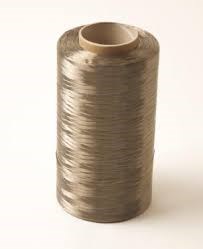Can basalt fiber bridge the gap between glass and carbon?
When I started writing about composites in the way, way back, industry innovator Brandt Goldsworthy was still alive. His article on basalt fiber was one of the most-read columns in the old Composites Technology book, and there seems to be a lot of interest in this alternative performance fiber. Mafic SA is a new player in the basalt fiber market.

Basalt roving from Mafic SA performs better than E-glass in a new testing report.
When I started writing about composites in the way, way back, industry innovator Brandt Goldsworthy was still alive, and in fact, writing columns for us for a time. His article on basalt fiber was one of the most-read columns in the old Composites Technology book, based on subsequent reader inquiries, and there seems to be a lot of interest in this alternative performance fiber.
What is basalt fiber, anyway? As CW explained in our August 2006 story on the subject (here’s a link: http://www.compositesworld.com/articles/basalt-fibers-alternative-to-glass) Frenchman Paul Dhé was the first with the idea to extrude fibers from basalt rock, a common igneous rock material. He was granted a U.S. patent in 1923. Around 1960, both the U.S. and the former Soviet Union (USSR) began to investigate basalt fiber applications, particularly for military hardware. In the northwestern U.S., where large basalt formations are concentrated, Prof. R.V. Subramanian of Washington State University (Pullman, Wash.) conducted research that correlated the chemical composition of basalt with the conditions for extrudability and physio-chemical characteristics of the resulting fiber. Owens Corning and several other glass companies conducted independent research programs, which resulted in several U.S. patents. Around 1970, however, U.S. glass companies abandoned basalt fiber research for strategies that favored their core product, which resulted in better glass fiber including successful development of S-2 glass.
During the same period, research in Eastern Europe, which had been carried out in the 1950s by independent groups in Moscow, Prague and other locales, was nationalized by the USSR's Defense Ministry and concentrated in Kyiv, Ukraine, where technology was subsequently developed in closed institutes and factories. After the breakup of the Soviet Union in 1991, the results of Soviet research were declassified and made available for civilian applications. Basalt fiber research, production and marketing efforts initially emanated from countries once aligned with the Soviet bloc, and include Kamenny Vek (Dubna, Russia), Technobasalt (Kyiv, Ukraine), Hengdian Group Shanghai Russia & Gold Basalt Fibre Co. (Shanghai, China), and OJSC Research Institute Glassplastics and Fiber (Bucha, Ukraine). Since 2012, a new player on the market is Mafic SA (Kells, County Meath, Ireland), with offices in the US and Ireland and production in Ireland.
The igneous rock is mined and melted, with no performance additives required, and is extruded into filaments, similar to glass fiber production. The fibers have alkali chemical resistance and fire resistance reportedly better than E-glass, and, better mechanical properties as well, as documented in a new testing report from Mafic, in collaboration with the Fraunhofer Project Center (London, Ontario, Canada). Test panels were fabricated using basalt fabrics in an epoxy matrix using high-pressure resin transfer molding (HPRTM), then tested for physical properties, including tensile strength, impact strength and interlaminar shear. The results show that, when compared to E-glass panels made with the same resin, basalt has higher tensile modulus and strength, and an interlaminar shear strength midway between glass and carbon fiber comparison panels. According to the Fraunhofer report, the basalt composite showed a specific strength 40% higher than E-glass, and a specific stiffness 20% higher than the glass composite.
Basalt could be a good choice for applications needing higher performance than glass, but where the cost of carbon can’t be justified. Mafic’s marketing manager Jeffrey Thompson points out that “For a part currently using fiberglass, it would be possible to use Mafic Basalt Fiber to achieve the same part performance with reduced part mass. Alternatively, using Mafic Basalt could increase part strength and stiffness without dramatic cost increases.” Mafic will have a stand at the upcoming JEC World exhibition in Paris, March 8 – 10, and will have material and parts on display. If you can’t make it to Paris, we’ll be writing blogs and show reports, and Mafic will be covered along with the other exhibitors — hope to see you there! To get more information on Mafic's fiber, send your inquiry to this email address: info@mafic.com.
Related Content
Spanish startup to ramp up production of “recyclable” EV prototype
Liux’s BIG electric vehicle features multiple structural components manufactured via RTM from flax fabric and a thermoset resin said to enable the entire component to be recycled and reused again.
Read MoreOtto Aviation launches Phantom 3500 business jet with all-composite airframe from Leonardo
Promising 60% less fuel burn and 90% less emissions using SAF, the super-laminar flow design with windowless fuselage will be built using RTM in Florida facility with certification slated for 2030.
Read MoreBucci Composites expands automotive production capabilities with facility addition, new high-ton presses
CW Top Shops recipient Bucci Composites shares an update on its facility expansion, automotive composites applications, sustainability, education initiatives and more.
Read MoreASCEND program completion: Transforming the U.K.'s high-rate composites manufacturing capability
GKN Aerospace, McLaren Automotive and U.K. partners chart the final chapter of the 4-year, £39.6 million ASCEND program, which accomplished significant progress in high-rate production, Industry 4.0 and sustainable composites manufacturing.
Read MoreRead Next
Scaling up, optimizing the flax fiber composite camper
Greenlander’s Sherpa RV cab, which is largely constructed from flax fiber/bio-epoxy sandwich panels, nears commercial production readiness and next-generation scale-up.
Read MoreCeramic matrix composites: Faster, cheaper, higher temperature
New players proliferate, increasing CMC materials and manufacturing capacity, novel processes and automation to meet demand for higher part volumes and performance.
Read MoreUltrasonic welding for in-space manufacturing of CFRTP
Agile Ultrasonics and NASA trial robotic-compatible carbon fiber-reinforced thermoplastic ultrasonic welding technology for space structures.
Read More












